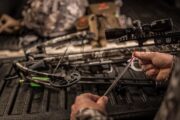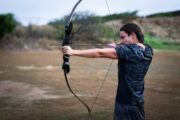The shotgun is one of the most versatile types of weapons as it can be used for hunting, competition, and even home defence. However, it’s a little harder to use, and it’s more situational, so there’s more to consider during the research and shopping stages. So, whether you’re looking for a defence shotgun to protect your family and property, a hunting shotgun to put food on the table, or a historical firearm that offers a connection to the past, here are a few tips to help guide you through the process.
Get Familiar with Different Types and Parts

Whenever you decide to arm yourself up by choosing from the wide selection of hunting and law enforcement shotguns, it may be helpful to review some anatomy and terminology first. The gauge of a shotgun is comparable to the calibre of rifles and handguns. It indicates the shot’s size and force; a lower gauge denotes larger, more lethal projectiles.
From smallest to largest, the most widely used shotgun gauges are 410, 20, 12, and 10. The equivalent of bullets in a shot gun are shells. The portion of the gun that fires projectiles is called the barrel. The part of the barrel that is filled with rounds furthest rearward is called the chamber, sometimes known as the breech.
Shells are either manually put into the chamber, into a detachable magazine, or a tube, depending on the type of shotgun. The elevator transports shells from the tube into the chamber (in pump-action and some semi-automatic types). When firing, the shooter’s shoulder is supported and stabilized by the stock, if it is there. In place of stocks, shot guns with pistol grips have smaller but more difficult-to-use grips.
Both a stock and a pistol grip are seen on some models. When the trigger is pressed, the firing pin is activated. The gun fires as a result of the firing pin striking the primer of the round that is presently put into the chamber. The forend of a pump-action shotgun is cycled by pushing it to the rear and then back to its starting position.
A top lever on break-action variants is used to open the breech for loading and unloading. On the other hand, there are three shotgun varieties that are authorized for civilian ownership: pump, semi-automatic, and break open. The mechanism via which a firearm functions is called the “action”. The shotguns for sale can employ around a dozen different types of ammunition, however the most are quite rare and specialized.
Slugs and shot are the two most prevalent types available. Shotshells can contain four to several dozen spherical balls, which disperse and strike the target at the same time, wreaking havoc across a large surface area. Slugs, on the other hand, are solitary, heavy projectiles that concentrate all of the shotgun’s powerful muzzle energy into one point of contact. Slugs are perfect for taking down big wildlife or piercing through thick barriers or armour.
Consider Your Needs

Most shotgun owners use their weapons primarily (but not always only) for home defence; many shotguns are equally effective for a variety of purposes. Pump-action 12-gauge types are particularly well-liked for home defence because of their exceptional stopping power, reasonable price, and mechanical dependability. Overall length, capacity, and gauge are critical factors to take into account while choosing.
The best types, however, for home defence are 12- and 20-gauge models because they have a lot of stopping power without being so strong that overpenetration becomes a serious issue. Generally, buckshot (number four), which we recommend, works better because slugs are much more likely to pierce numerous walls and perhaps cause injuries or fatalities to innocent onlookers.
The shotguns with short barrels are usually not good for hunting. For better accuracy, the majority of hunters choose longer barrels. Larger, heavier barrels may also endure higher powerful slugs, which are popular among big game hunters. All in all, your choice of gauge and ammo type will be largely influenced by the game you hunt. Naturally, the smaller game requires lighter bullets and smaller gauges.
For sport shooting, the type of shotgun you’ll need depends almost entirely on the sport in question, whether you want to fire them for fun or competition. For example, semi-automatic models are pricey and of higher quality, whereas recreational 3-gun shooters typically use mid-range pump guns. In contrast, trap and skeet shooters are typically mandated to utilize shot guns that are either pump-action or break-action. There can be other regulations regarding gauges and ammunition types in the club or league you join.
Know the Law
When on the hunt for the right shotgun for your needs, consider the law. The only weapons that are restricted or outlawed in Canada are assault rifles and pistols. As long as you have the proper licence, Canadians are allowed to lawfully buy and possess thousands of different models of shot guns and rifles. However, you must complete a firearms safety course and obtain a background check before you may obtain a license.


